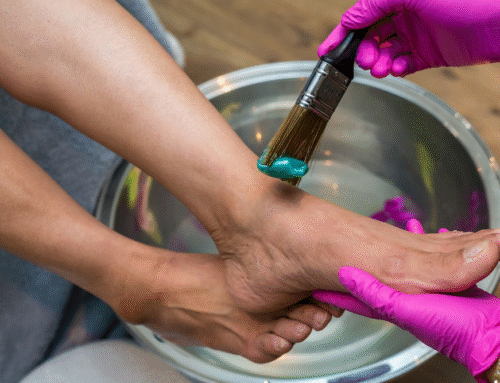If you’re dealing with thick, discolored, or brittle toenails because of a fungal infection, you may be wondering whether soaking fungal toenails to soften them is a good idea. A warm foot soak can definitely make nails easier to trim and relieve some pressure, but soaking alone usually isn’t enough to clear toenail fungus.
At Laser Nail Therapy, we help patients treat the root cause of toenail fungus and restore clear, healthy nails. In this guide, we’ll explain how soaking works, how to do it safely, and why it should be one part of a larger treatment plan.
Why Fungal Toenails Become Thick and Hard
Toenail fungus, or onychomycosis, happens when microscopic fungi infect the nail and the skin underneath it. Over time, the infection causes the nail to change in both appearance and texture. You might notice:
- Nails are becoming thick, hard, or brittle
- Yellow, brown, or white discoloration
- Crumbling edges or misshapen nails
- An unpleasant odor or discomfort in shoes
The fungus often lives under the nail plate and in the nail bed, which makes it difficult for simple home remedies to reach. According to the American Academy of Dermatology, nail fungus is one of the most common nail conditions seen by doctors.
Can Soaking Fungal Toenails to Soften Them Help?
Yes — soaking fungal toenails to soften them can be helpful as part of your care routine. A warm soak can:
- Soften thick nail plates so they are easier and safer to trim
- Reduce pressure and discomfort in shoes
- Help loosen debris under and around the nail
- Prepare the nail surface so other treatments can work better
However, it’s important to remember that soaking does not kill the fungus deep under the nail. Think of soaking as a support step, not the main treatment.
How to Soak Fungal Toenails to Soften Them Safely
Here is a simple, safe way to soak fungal toenails to soften them at home:
- Fill a basin with warm water. It should be comfortable to the touch, not hot.
- Add a soak ingredient if you like:
- 1/2–1 cup of Epsom salt to help soften nails and soothe skin
- Or a mix of 1 part vinegar to 2–3 parts warm water for a mild antifungal boost
- Soak your feet for 15–20 minutes. For very thick nails, up to 30 minutes is okay.
- Dry your feet thoroughly, including between the toes. Fungus loves moisture, so this step is crucial.
- Trim or file the nails gently while they are soft, if you can do so comfortably. Use clean, disinfected tools.
- Apply your treatment right after the soak — whether that’s a topical product or preparing for professional laser treatment.
Never soak your feet in very hot water, harsh chemicals, or anything that irritates your skin. If you have diabetes or poor circulation, talk to your doctor before starting any soaking routine.
What Soaking Can and Can’t Do
Soaking fungal toenails to soften them is helpful, but there are limits to what it can accomplish on its own.
What Soaking Can Do
- Make thick, hard nails easier to cut
- Relieve pressure and discomfort from overgrown nails
- Help keep the nail area cleaner
- Support other treatments by improving nail condition
What Soaking Cannot Do
- Reach the fungus deep under the nail plate
- Fully cure a fungal nail infection
- Prevent fungus from coming back on its own
For most people, soaking should be combined with a more targeted treatment plan to effectively clear the infection.
Best Practices After a Toenail Soak
To get the most benefit from soaking and to protect your nails, follow these tips after each soak:
- Pat your feet completely dry with a clean towel.
- Put on clean, dry socks made from breathable, moisture-wicking material.
- Wear shoes that allow air to circulate and avoid tight, sweaty footwear.
- Disinfect nail clippers, files, and foot tubs after use.
- Avoid walking barefoot in public showers, locker rooms, and pool areas.
- Stick with a routine — good foot hygiene is key to preventing fungus from spreading.
These simple habits make it harder for fungus to survive and help support whatever treatment plan you and your provider choose.
When to See a Specialist
If you’ve been soaking fungal toenails to soften them, using over-the-counter products, and still notice thick, discolored nails, it’s time to talk to a specialist. You should schedule an evaluation if:
- The nail is getting thicker, darker, or more painful
- Several nails are now affected
- The nail is lifting from the nail bed
- You have diabetes or poor circulation
- You feel self-conscious about showing your feet
A professional can confirm whether it’s truly fungus (not another nail condition) and recommend a treatment that addresses the infection at its source.
Laser Treatment: A Long-Term Solution for Fungal Toenails
While soaking fungal toenails to soften them is a helpful step, it usually isn’t enough to clear a stubborn infection. That’s where laser toenail fungus treatment comes in.
At Laser Nail Therapy, we use advanced, FDA-cleared laser technology that targets the fungus underneath the nail without harming the surrounding skin. Treatment is quick, comfortable, and medication-free, and most patients can return to normal activities right away.
As your nails grow out after laser treatment, you’ll see healthier, clearer nails gradually replace the infected areas — especially when you combine treatment with good foot hygiene and smart soaking habits.
Ready to Restore Your Nails?
If soaking and home care haven’t given you the results you want, we’re here to help. Healthy, clear nails are possible.
Schedule your consultation with Laser Nail Therapy today to see whether laser toenail fungus treatment is right for you.
Prefer to call? (800) 672-0625




